The exhibition will be on display at Luxembourg airport in August 2024, between Terminal A and Terminal B.
Each photo is available for purchase in aid of the 1 Ocean Foundation - more information from nancy.thomas@imslux.lu
The Valley of a Thousand Roses - French Polynesia
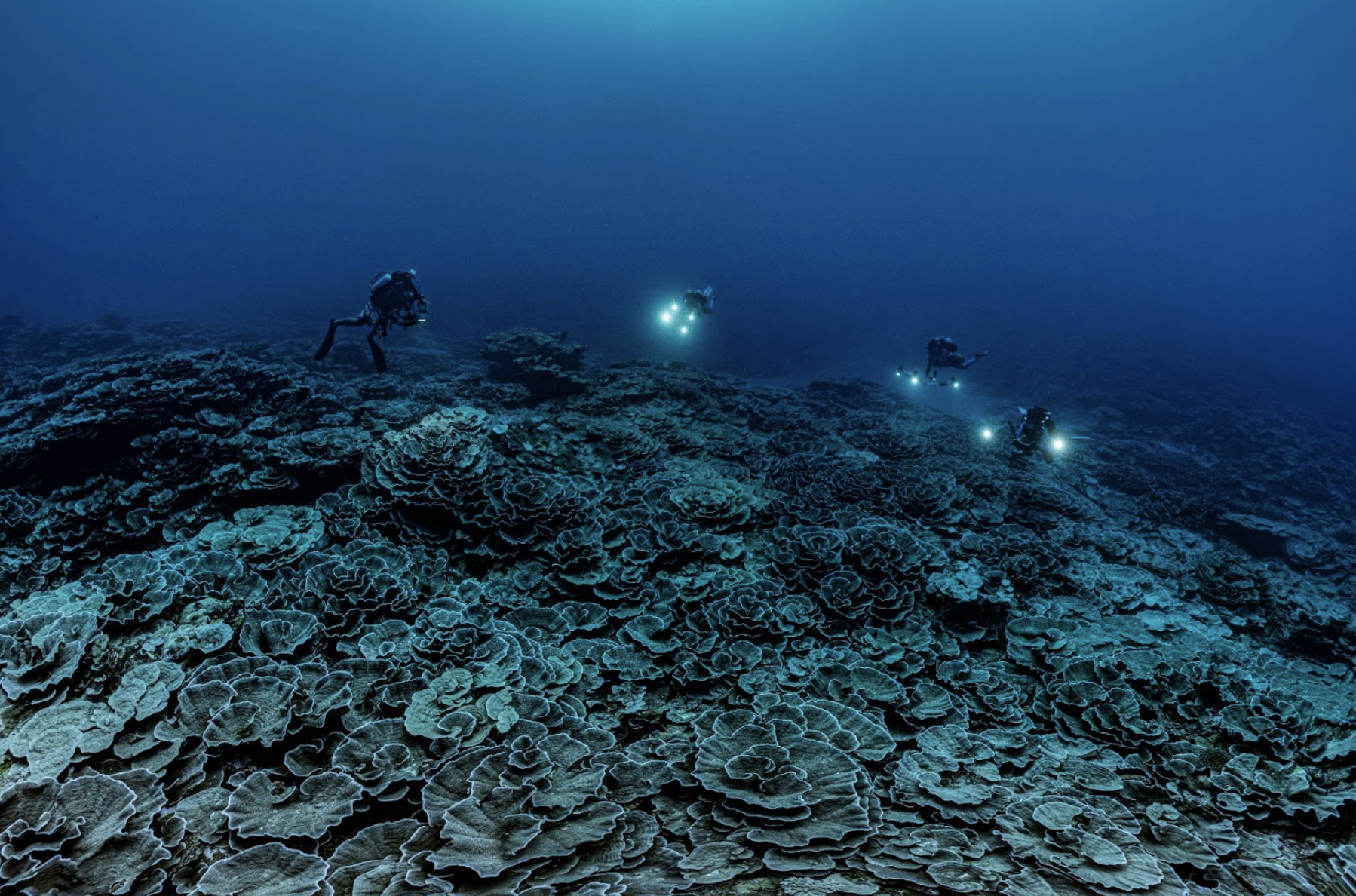
Off the coast of Tahiti, the 1 OCEAN team and scientists from the CRIOBE-CNRS have revealed the existence of an extraordinary reef at a depth of between 35 and 80 metres. Worthy of the work of a great couturier, the Valley of a Thousand Roses enchants its viewers with its singular aesthetics and its strange petals pointing towards the surface, thanks to which the corals manage to capture the light essential to their survival. During this mission, the divers covered almost three kilometres without reaching the limits of the reef. For the scientists, this is a major scientific discovery: the Valley of a Thousand Roses could be one of the most extensive deep reefs in the world, in an unequalled state of conservation. Today, deep reefs - or mesophotic reefs - remain extremely poorly known. Protected from the effects of global warming, they could nonetheless be the future of coral reefs.
The great migration of life - South Africa
 Every year, when the southern winter arrives, an extraordinary animal impulse sends shivers down the east coast of South Africa. For reasons that still elude us, several million sardines leave the Cape of Good Hope at the same time to migrate northwards. Gigantic shoals formed, darkening the sea. This was the start of a long journey of more than 1500 kilometres, from the Bay of Algoa to the south coast of Kwazulu Natal. Almost immediately, tens of thousands of dolphins, sharks, Cape gannets and Bryde's whales join the party, giving rise to scenes of predation on an unparalleled scale. In terms of biomass, this is the largest migration in the animal kingdom. Here, common dolphins are speeding towards their prey. Their aim: to break up the sardines to make the hunt easier.
Every year, when the southern winter arrives, an extraordinary animal impulse sends shivers down the east coast of South Africa. For reasons that still elude us, several million sardines leave the Cape of Good Hope at the same time to migrate northwards. Gigantic shoals formed, darkening the sea. This was the start of a long journey of more than 1500 kilometres, from the Bay of Algoa to the south coast of Kwazulu Natal. Almost immediately, tens of thousands of dolphins, sharks, Cape gannets and Bryde's whales join the party, giving rise to scenes of predation on an unparalleled scale. In terms of biomass, this is the largest migration in the animal kingdom. Here, common dolphins are speeding towards their prey. Their aim: to break up the sardines to make the hunt easier.
Noah's Ark from the depths - Mediterranean Sea
ALR0074003
 In the summer of 2022, particularly high temperatures led to a massive die-off of red gorgonians (Paramuricea Clavata), an emblematic animal endemic to the Mediterranean. The cause is a bacterium similar to that responsible for cholera in humans, which proliferates when temperatures become too high. However, gorgonians living below 30 metres remain relatively unaffected for the time being, protected from heat waves by surface waters that act as a thermal shield. In response to the climate emergency, UNESCO and the 1 OCEAN Foundation have launched the ‘Noah's Ark of the Deep’ scientific exploration programme. The aim: to understand how deep-sea areas could become a refuge for this unique species, an essential cornerstone of Mediterranean biodiversity.
In the summer of 2022, particularly high temperatures led to a massive die-off of red gorgonians (Paramuricea Clavata), an emblematic animal endemic to the Mediterranean. The cause is a bacterium similar to that responsible for cholera in humans, which proliferates when temperatures become too high. However, gorgonians living below 30 metres remain relatively unaffected for the time being, protected from heat waves by surface waters that act as a thermal shield. In response to the climate emergency, UNESCO and the 1 OCEAN Foundation have launched the ‘Noah's Ark of the Deep’ scientific exploration programme. The aim: to understand how deep-sea areas could become a refuge for this unique species, an essential cornerstone of Mediterranean biodiversity.
Smoking land’ hydrothermal vents - Aeolian Archipelago, Mediterranean Sea
ALR0071005
 ‘The underwater volcanoes of Panarea are one of the most striking landscapes I have ever seen. Sometimes you're more than seventy metres down, in the middle of a field of volcanic vents spewing out hot, toxic fluids... It's a breathtaking atmosphere, where you're both enveloped by the infinite silence of the ocean and witnessing this Dantesque spectacle, a bit like standing at the gates of hell. You realise that the Earth is alive. From the surface, you'd never suspect a thing. - Alexis Rosenfeld
‘The underwater volcanoes of Panarea are one of the most striking landscapes I have ever seen. Sometimes you're more than seventy metres down, in the middle of a field of volcanic vents spewing out hot, toxic fluids... It's a breathtaking atmosphere, where you're both enveloped by the infinite silence of the ocean and witnessing this Dantesque spectacle, a bit like standing at the gates of hell. You realise that the Earth is alive. From the surface, you'd never suspect a thing. - Alexis Rosenfeld
Volcanic gas eruption - Aeolian Archipelago, Mediterranean Sea
ALR0071003
 At a depth of just a few metres, gas erupts from the volcano's magma chamber in the form of impressive curtains of bubbles. In some areas, the volcano is even releasing more than a million litres of gas a day. At the base of the gas columns, the floor is dotted with white spots. These are actually clusters of bacteria that feed mainly on carbon and form the first link in the food chain.
At a depth of just a few metres, gas erupts from the volcano's magma chamber in the form of impressive curtains of bubbles. In some areas, the volcano is even releasing more than a million litres of gas a day. At the base of the gas columns, the floor is dotted with white spots. These are actually clusters of bacteria that feed mainly on carbon and form the first link in the food chain.
Coral bleaching - Moorea, French Polynesia
ALR0062003
 Faced with global warming, this coral colony is bleaching. Coral is unique in that it lives in symbiosis with algae, which live inside its tissues. It is this algae that gives the coral all its colour and provides most of its energy through photosynthesis. However, when the temperature becomes too hot, the animal expels the algae and bleaches. If temperatures do not quickly return to normal, the coral will die in just a few weeks.
Faced with global warming, this coral colony is bleaching. Coral is unique in that it lives in symbiosis with algae, which live inside its tissues. It is this algae that gives the coral all its colour and provides most of its energy through photosynthesis. However, when the temperature becomes too hot, the animal expels the algae and bleaches. If temperatures do not quickly return to normal, the coral will die in just a few weeks.
Mushroom corals - Gambiers Archipelago, French Polynesia
ALR0047007
 Fungia, or ‘mushroom corals’, are circular or oval hard corals that have the particularity of not being fixed to the seabed and of being able to move around. Made up of a single polyp rather than a colony, this solitary coral must come together to reproduce. Here in Rikitea lagoon, several dozen individuals have come together to facilitate the exchange of reproductive gametes.
Fungia, or ‘mushroom corals’, are circular or oval hard corals that have the particularity of not being fixed to the seabed and of being able to move around. Made up of a single polyp rather than a colony, this solitary coral must come together to reproduce. Here in Rikitea lagoon, several dozen individuals have come together to facilitate the exchange of reproductive gametes.
Young turtle discovering the open sea - Tetiaroa Atoll, French Polynesia
ALR0046015
 After spending more than two months in a nest dug in the sand, this young turtle leaves the beach to head out to sea. If it escapes predators, it will return to the same beach in several years' time and dig a nest for its offspring. Located in the Society archipelago, Tetiaroa atoll is an important nesting site for green turtles. As throughout French Polynesia, they are strictly protected here.
After spending more than two months in a nest dug in the sand, this young turtle leaves the beach to head out to sea. If it escapes predators, it will return to the same beach in several years' time and dig a nest for its offspring. Located in the Society archipelago, Tetiaroa atoll is an important nesting site for green turtles. As throughout French Polynesia, they are strictly protected here.
A city under the sea - Maldives
ALR0043066
 Coral reefs may cover just 0.2% of the ocean floor, but they are home to over a quarter of all marine biodiversity. Teeming with life, healthy reefs are like cities under the sea. Here, in the Maldives, an anemone shelters two Seba clownfish, watched by an orange-striped triggerfish. Damselfish, fusiliers and soldier-fish fly overhead and you can even make out the silhouette of a tuna near the surface. Alcyonaria, sponges and antipatharia complete this fabulous fresco of life.
Coral reefs may cover just 0.2% of the ocean floor, but they are home to over a quarter of all marine biodiversity. Teeming with life, healthy reefs are like cities under the sea. Here, in the Maldives, an anemone shelters two Seba clownfish, watched by an orange-striped triggerfish. Damselfish, fusiliers and soldier-fish fly overhead and you can even make out the silhouette of a tuna near the surface. Alcyonaria, sponges and antipatharia complete this fabulous fresco of life.
Green turtle mating scene - Mayotte, Indian Ocean
ALR0034119
 The first time, you always see just one turtle. It's only then that you realise what the image really shows: two green turtles mating in open water, one on top of the other. Placed on top of the female, the male clings to his partner's shell using the claws on his flippers. These play a vital role in reproduction. Essentially herbivores, these turtles feed in the sea grass beds, which are particularly abundant in the Mayotte region. Created in 2010, the Mayotte Nature Park is the first marine park set up by France in its overseas territories.
The first time, you always see just one turtle. It's only then that you realise what the image really shows: two green turtles mating in open water, one on top of the other. Placed on top of the female, the male clings to his partner's shell using the claws on his flippers. These play a vital role in reproduction. Essentially herbivores, these turtles feed in the sea grass beds, which are particularly abundant in the Mayotte region. Created in 2010, the Mayotte Nature Park is the first marine park set up by France in its overseas territories.
Humpback whale and calf - Austral Islands Archipelago, French Polynesia
 At the end of the austral summer, humpback whales begin a migration of several thousand kilometres to the warm waters of tropical and subtropical regions. From June to October, they give birth, reproduce and nurse their only calf before setting off again for the richer waters of Antarctica. There they replenish their fat reserves by feeding mainly on krill and small fish.
At the end of the austral summer, humpback whales begin a migration of several thousand kilometres to the warm waters of tropical and subtropical regions. From June to October, they give birth, reproduce and nurse their only calf before setting off again for the richer waters of Antarctica. There they replenish their fat reserves by feeding mainly on krill and small fish.
Shadow Games - Bahamas
ALR0027067
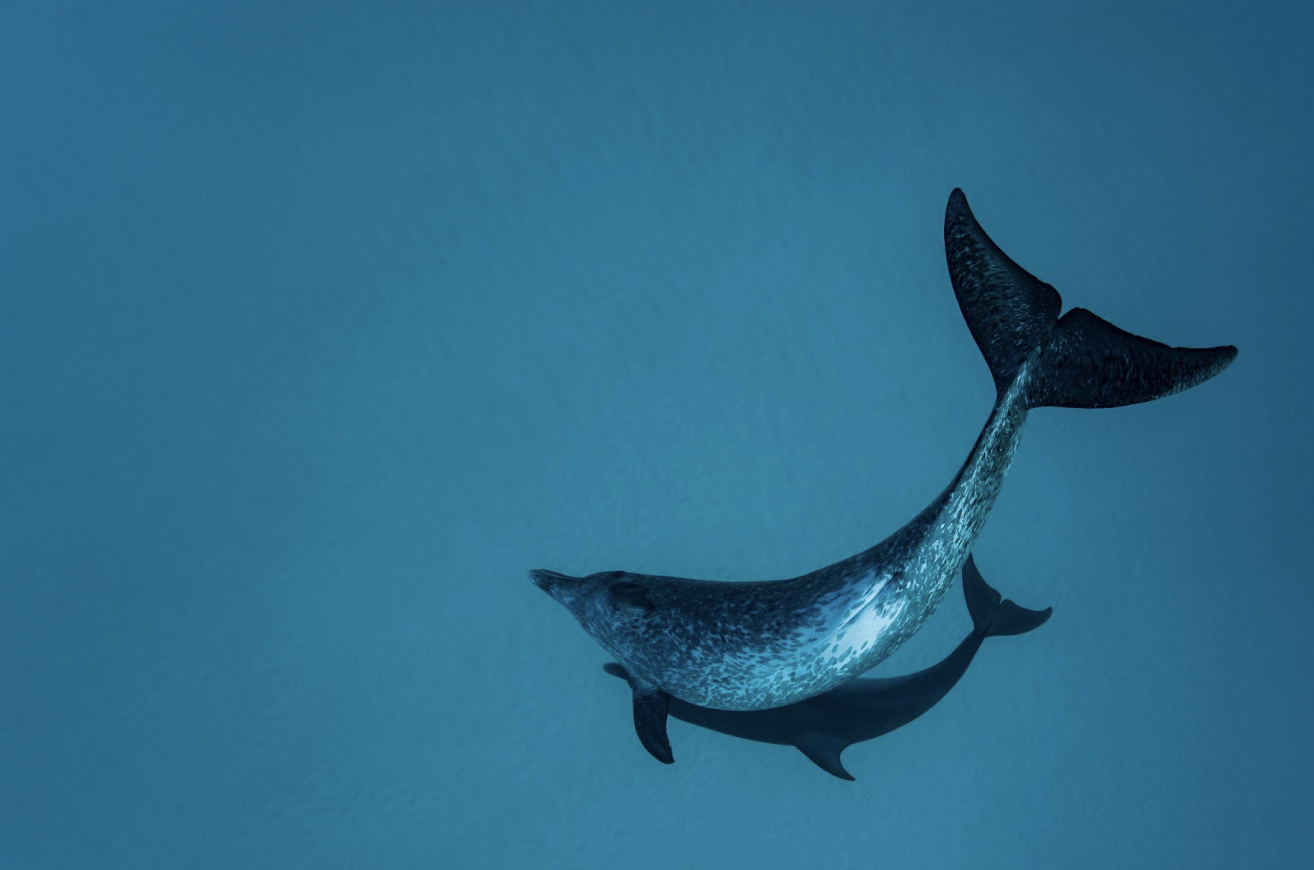 Spotted dolphins live mainly in the Gulf Stream, a warm ocean current that originates between Florida and the Bahamas. In the 1960s and 1970s, accidental catches in fishing nets caused the population to fall by 25%, but today, thanks to international regulations on tuna fishing and national protection measures, the pantropical spotted dolphin is the second most common cetacean after the bottlenose dolphin. Here, in the crystal-clear waters of the Bahamas, a spotted dolphin and a young bottlenose dolphin play side by side, almost giving the illusion of a single animal and its shadow on the sand.
Spotted dolphins live mainly in the Gulf Stream, a warm ocean current that originates between Florida and the Bahamas. In the 1960s and 1970s, accidental catches in fishing nets caused the population to fall by 25%, but today, thanks to international regulations on tuna fishing and national protection measures, the pantropical spotted dolphin is the second most common cetacean after the bottlenose dolphin. Here, in the crystal-clear waters of the Bahamas, a spotted dolphin and a young bottlenose dolphin play side by side, almost giving the illusion of a single animal and its shadow on the sand.
The last of the Sirenians
ALR0027016
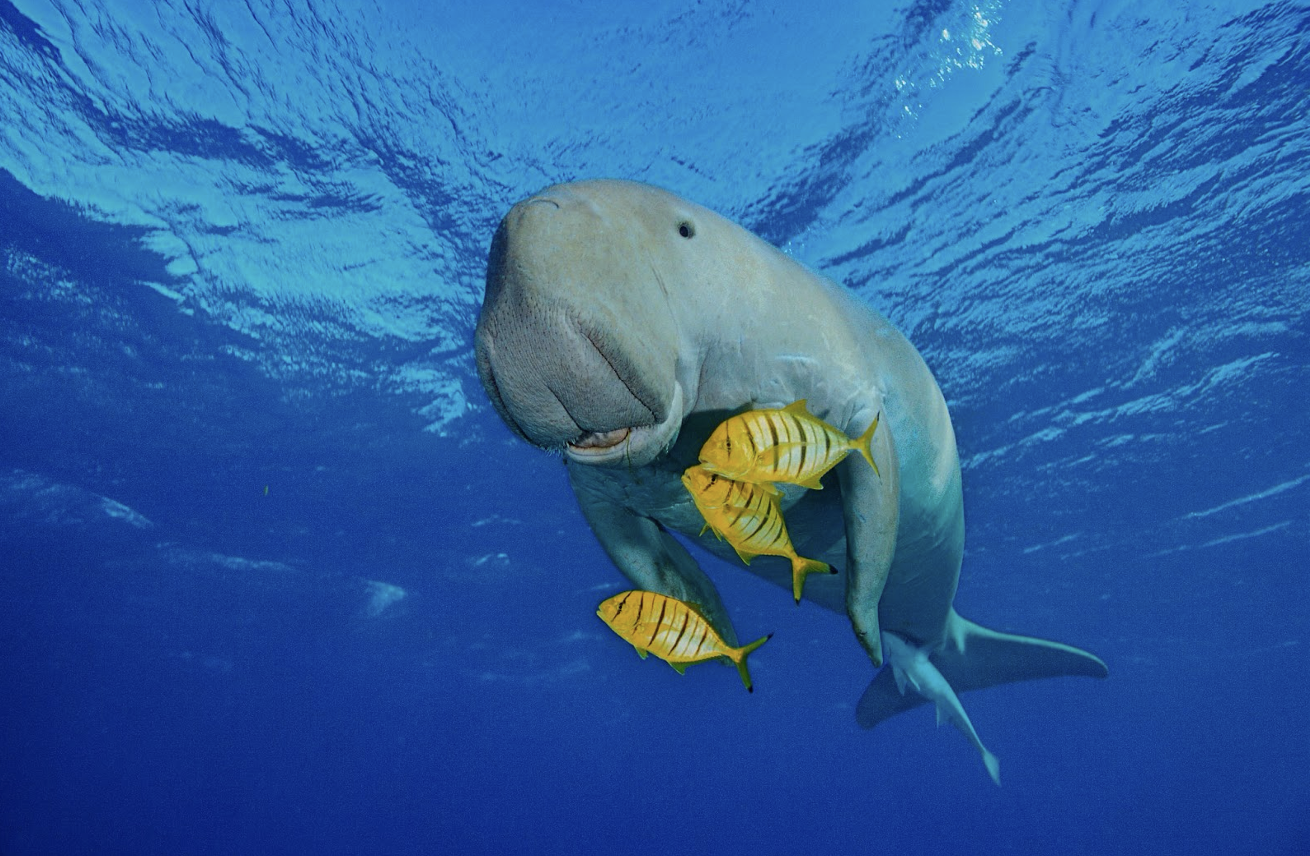 Along with manatees, their closest relatives, dugongs are the only marine mammals to be exclusively herbivorous. They feed by grazing on sea grass, earning them the nickname ‘sea cows’. They can swallow 30 to 40 kg of sea grass a day. The dugong and manatee are the only two remaining species of the sirenian order since the disappearance of Steller's rhytina in the 18th century, less than 30 years after its discovery by Westerners. Most dugongs live along the coast, making them extremely vulnerable to human pressures. In particular, they suffer the consequences of passing boats, fishing, pollution and the disappearance of seagrass beds. In 2019, there were fewer than 40,000 individuals left in the world.
Along with manatees, their closest relatives, dugongs are the only marine mammals to be exclusively herbivorous. They feed by grazing on sea grass, earning them the nickname ‘sea cows’. They can swallow 30 to 40 kg of sea grass a day. The dugong and manatee are the only two remaining species of the sirenian order since the disappearance of Steller's rhytina in the 18th century, less than 30 years after its discovery by Westerners. Most dugongs live along the coast, making them extremely vulnerable to human pressures. In particular, they suffer the consequences of passing boats, fishing, pollution and the disappearance of seagrass beds. In 2019, there were fewer than 40,000 individuals left in the world.
The world of Nemo
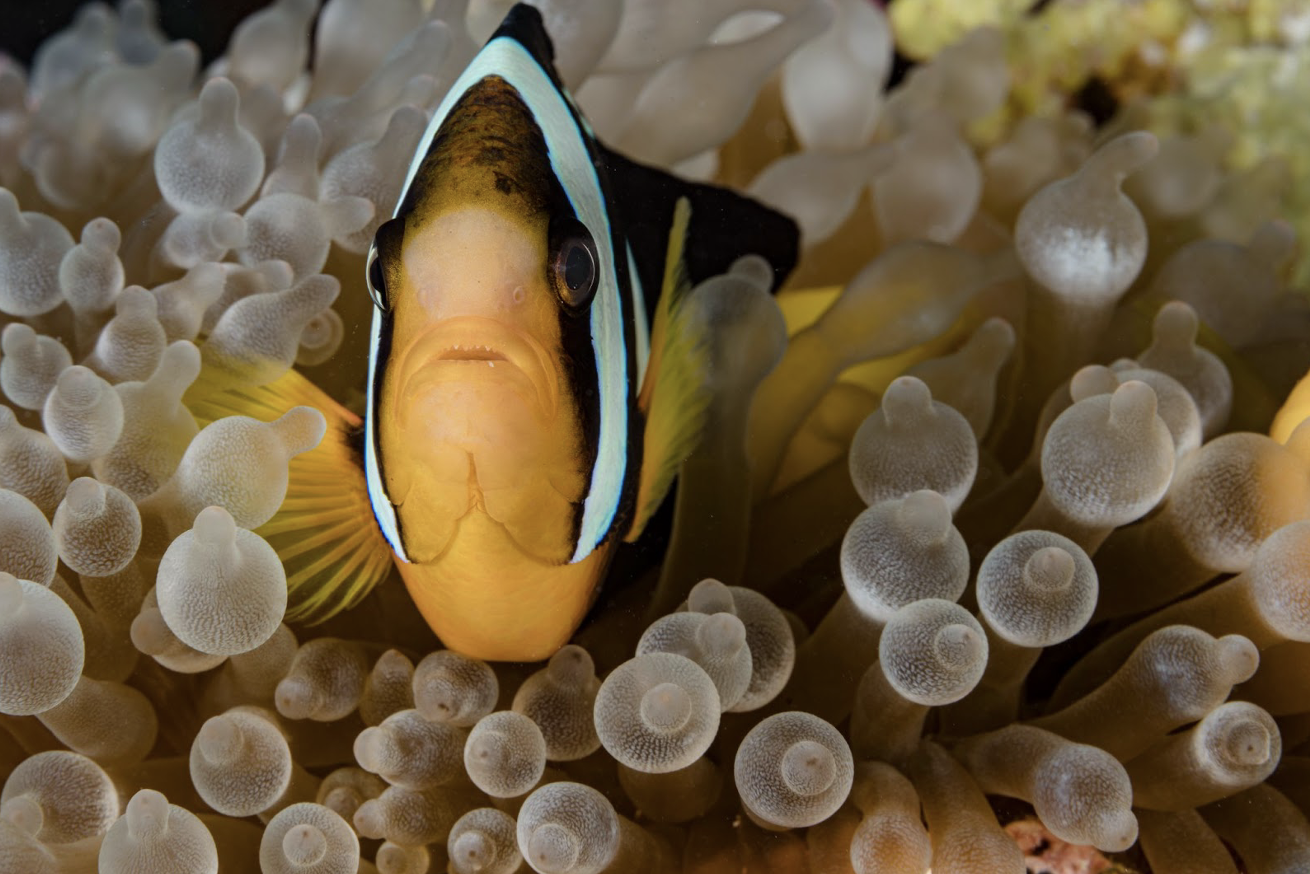 Anemones are a crucial refuge for the reproduction of the famous clownfish. Pairs meet and engage in courtship before preparing the nest in which to lay their eggs. In exchange for shelter, the fish fervently defend the anemone against predators: this is what is known as a mutualistic relationship, as each species benefits from the presence of the other.
Anemones are a crucial refuge for the reproduction of the famous clownfish. Pairs meet and engage in courtship before preparing the nest in which to lay their eggs. In exchange for shelter, the fish fervently defend the anemone against predators: this is what is known as a mutualistic relationship, as each species benefits from the presence of the other.
The biggest fish in the world - Djibouti, Indian Ocean
ALR0005016
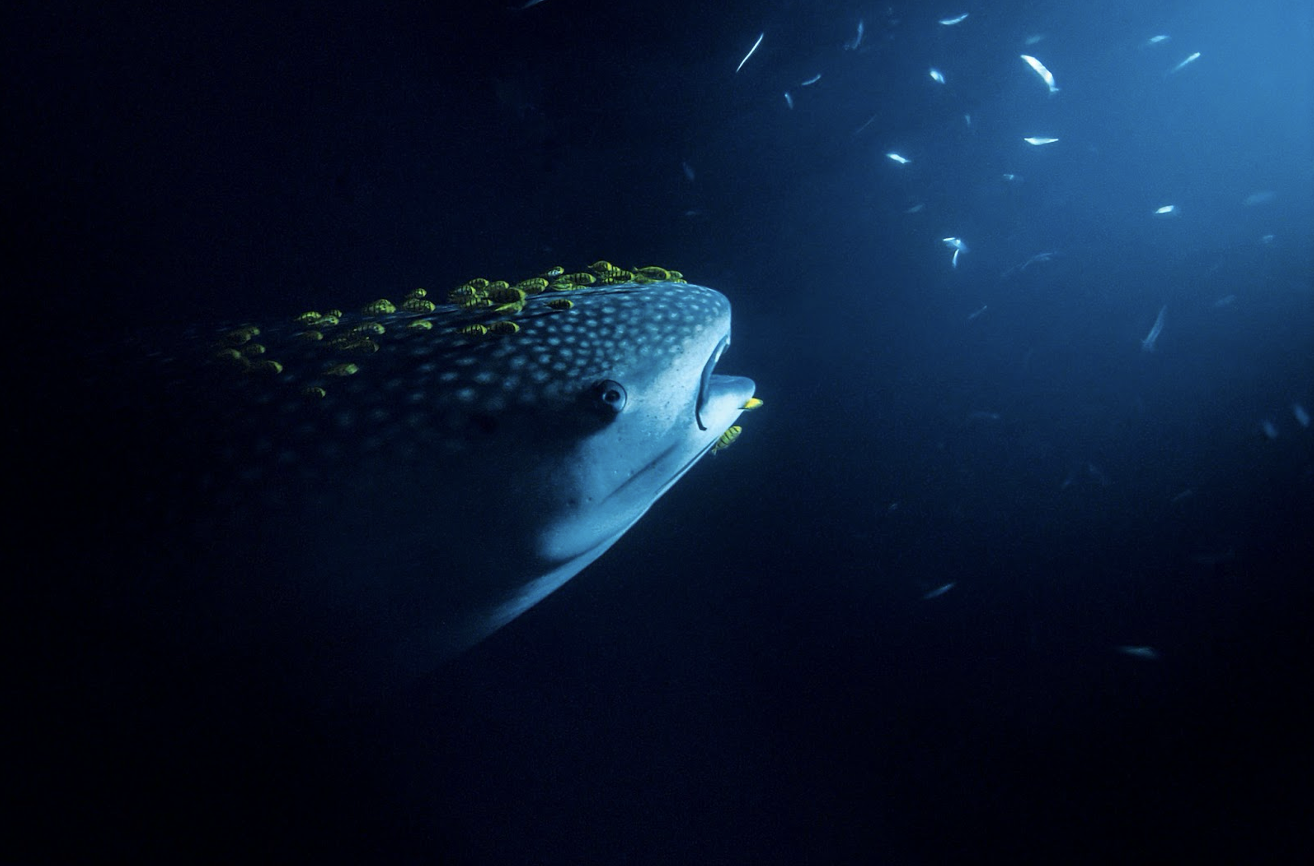 The whale shark is the largest fish in the world: it can measure 18 metres in length and weigh up to 50 tonnes! It is completely harmless to humans and feeds only on plankton. Its large, dark body is entirely marked with more or less regular white spots. Researchers use these spots like an identity card: they enable them to recognise different individuals! Whale sharks can be found throughout the tropical zone of the three great oceans. They usually live between the surface and a depth of around a hundred metres. Discovered by man in 1828, the whale shark has always been fished by local populations, as in Indonesia, where they are caught with harpoons. Today, they are protected in Australia, the Maldives and the Philippines. Here, the photographer decided to use powerful lights to attract the whale sharks at night, in pursuit of plankton.
The whale shark is the largest fish in the world: it can measure 18 metres in length and weigh up to 50 tonnes! It is completely harmless to humans and feeds only on plankton. Its large, dark body is entirely marked with more or less regular white spots. Researchers use these spots like an identity card: they enable them to recognise different individuals! Whale sharks can be found throughout the tropical zone of the three great oceans. They usually live between the surface and a depth of around a hundred metres. Discovered by man in 1828, the whale shark has always been fished by local populations, as in Indonesia, where they are caught with harpoons. Today, they are protected in Australia, the Maldives and the Philippines. Here, the photographer decided to use powerful lights to attract the whale sharks at night, in pursuit of plankton.
A capon in the Calanques National Park
ALR0004179
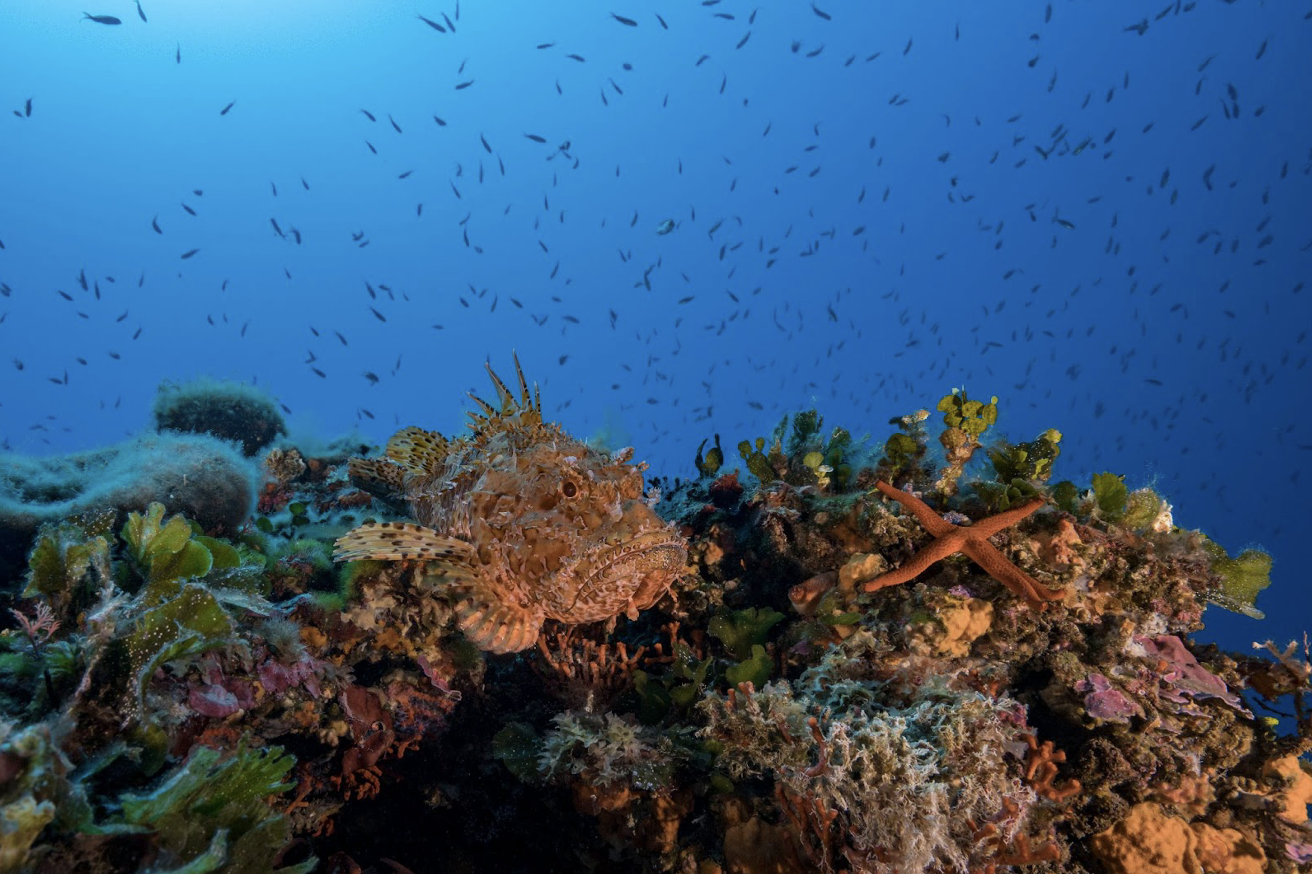 Masters of the art of camouflage, the capon - or large red scorpion fish - blends in perfectly with the rocky seabed. To defend itself, it can also rely on its dorsal fin, which is capable of delivering a powerful venom if bitten. Found throughout the Mediterranean, the capon is one of the species found in the Parc National des Calanques. Established in 2012, the park stretches between Marseille and La Ciotat and covers almost 2,630 hectares of sea.
Masters of the art of camouflage, the capon - or large red scorpion fish - blends in perfectly with the rocky seabed. To defend itself, it can also rely on its dorsal fin, which is capable of delivering a powerful venom if bitten. Found throughout the Mediterranean, the capon is one of the species found in the Parc National des Calanques. Established in 2012, the park stretches between Marseille and La Ciotat and covers almost 2,630 hectares of sea.
Lyre-tailed Barbet in a coral reef - Red Sea
ALR0024038
 Made up of Acropora hard corals and soft corals, this Red Sea reef is teeming with anthias, also known as lyre-tailed barbets. Most of the females here are orange. The males, which are much less numerous, are larger and violet in colour. However, this species is hermaphroditic: if a male dies, the dominant female in the group will change sex and become male.
Made up of Acropora hard corals and soft corals, this Red Sea reef is teeming with anthias, also known as lyre-tailed barbets. Most of the females here are orange. The males, which are much less numerous, are larger and violet in colour. However, this species is hermaphroditic: if a male dies, the dominant female in the group will change sex and become male.
Spotted dolphin and calf - Bahamas Archipelago, Bimini Island
ALR0027179
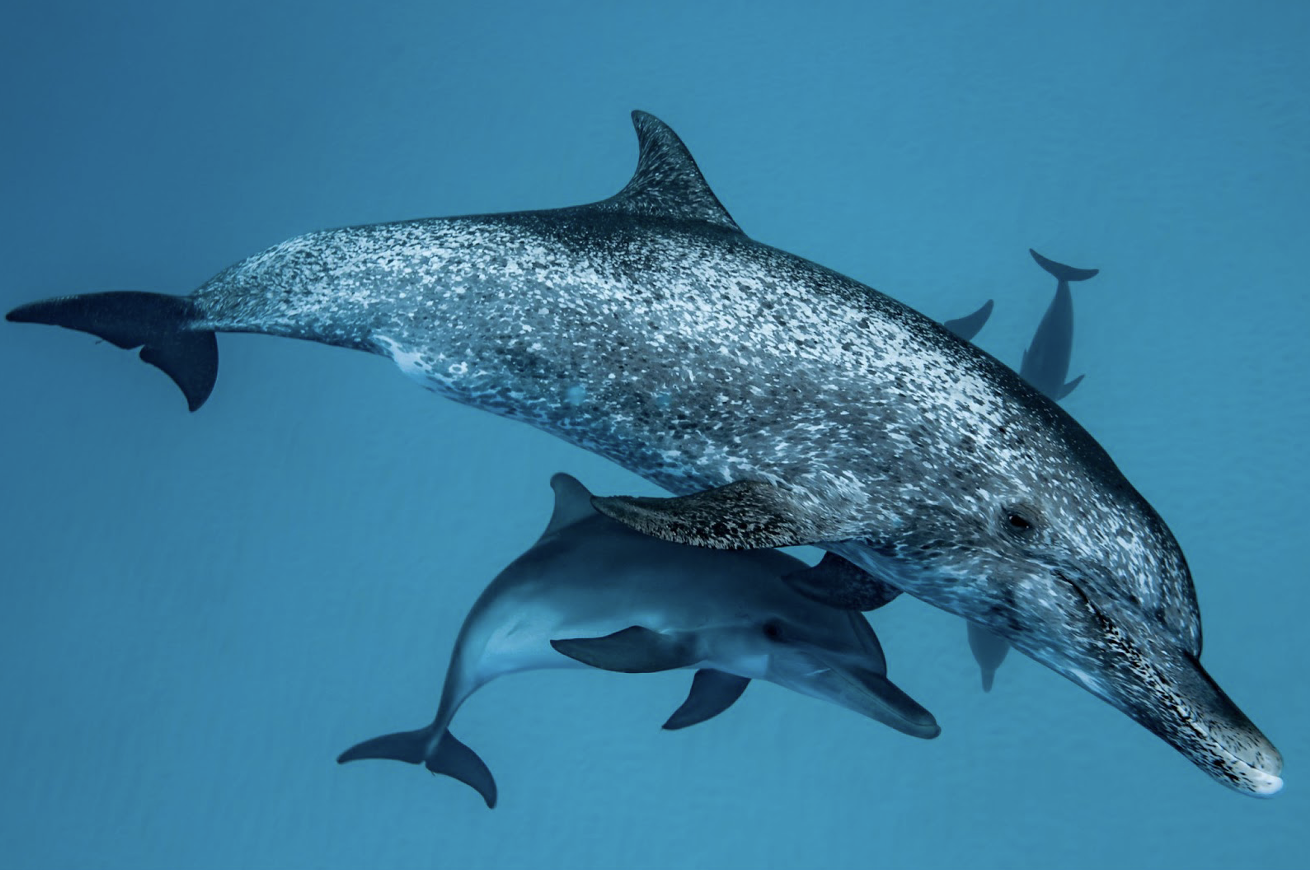 Once they have reached sexual maturity, female spotted dolphins give birth to a baby every 3 to 4 years. The baby, which has no spots, is nursed for a whole year and stays with its mother for almost 3 years. Spots appear at the age of one on the belly, flanks and back. By the age of two, the young dolphin is covered in spots. Like whale sharks, the coat of each spotted dolphin is unique.
Once they have reached sexual maturity, female spotted dolphins give birth to a baby every 3 to 4 years. The baby, which has no spots, is nursed for a whole year and stays with its mother for almost 3 years. Spots appear at the age of one on the belly, flanks and back. By the age of two, the young dolphin is covered in spots. Like whale sharks, the coat of each spotted dolphin is unique.
A trevally visiting the reef
ALR0047027
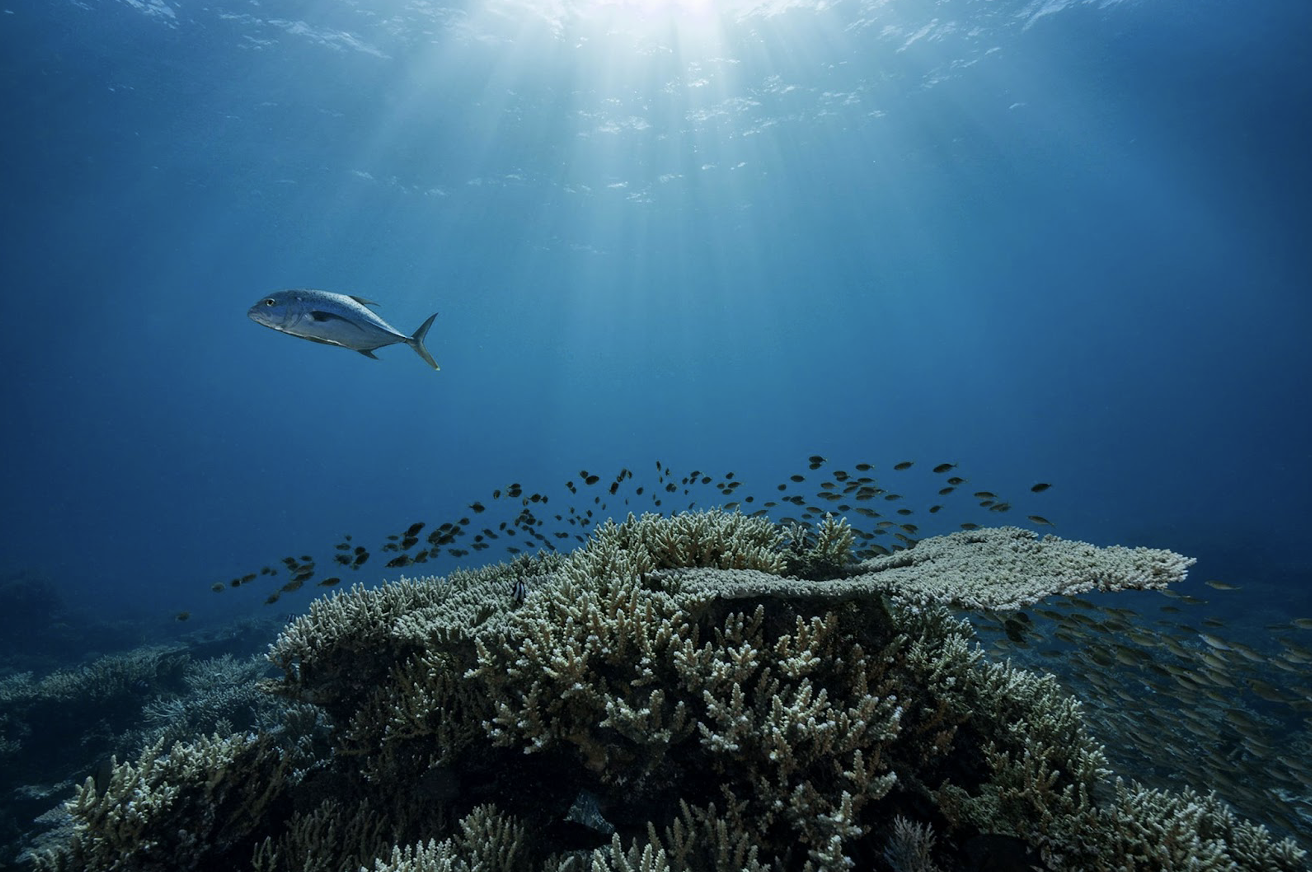 In the heart of the Gambier Archipelago, in French Polynesia, a superb toothed trevally passes over a reef, certainly in search of prey. Widespread in tropical and subtropical regions, the toothed trevally generally lives in shoals near the continental shelf. It feeds opportunistically, with a strong taste for worms, echinoderms and small molluscs. Some scientists even believe that the toothed trevally is capable of filtering water to feed on zooplankton!
In the heart of the Gambier Archipelago, in French Polynesia, a superb toothed trevally passes over a reef, certainly in search of prey. Widespread in tropical and subtropical regions, the toothed trevally generally lives in shoals near the continental shelf. It feeds opportunistically, with a strong taste for worms, echinoderms and small molluscs. Some scientists even believe that the toothed trevally is capable of filtering water to feed on zooplankton!
Coral Sea, the original ocean
ALR0073005
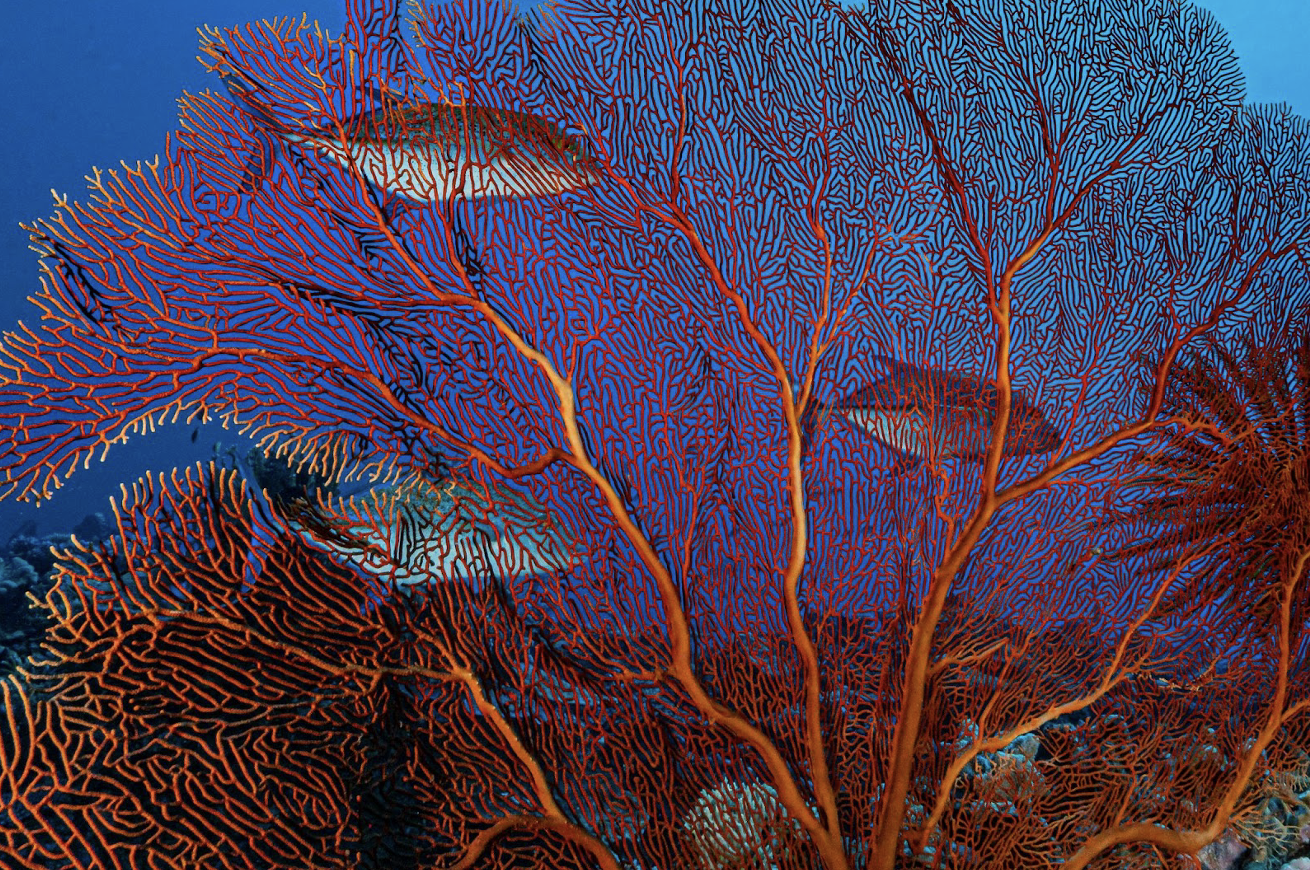
A veritable temple of marine biodiversity, the Coral Sea is one of the best preserved areas on the planet. Located between the Australian coast and the Vanuatu archipelago, the world's most pristine sea includes the Petrie and Astrolabe reefs, which hold the world record for fish density.
To protect this exceptional common asset, part of New Caledonia's waters has been transformed into a nature park covering 1.3 million square kilometres around the archipelago. This park is the largest marine protected area in France and the fourth largest in the world. At the heart of this protected environment, the d'Entrecasteaux reefs, a UNESCO World Heritage site, have had a unique destiny. After years of exploitation by man, in just a century they have once again become one of the wildest natural habitats on the planet.
